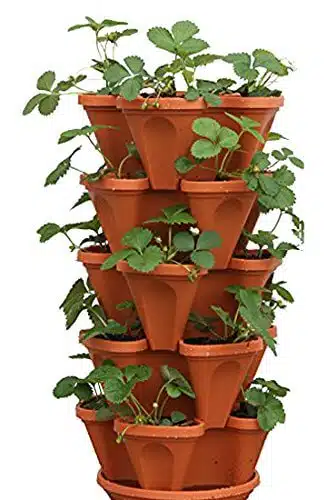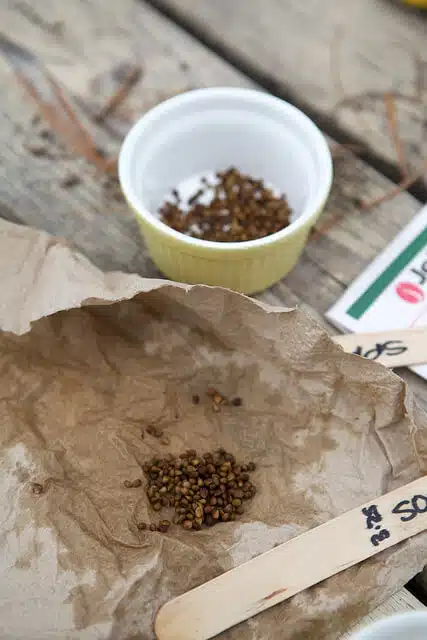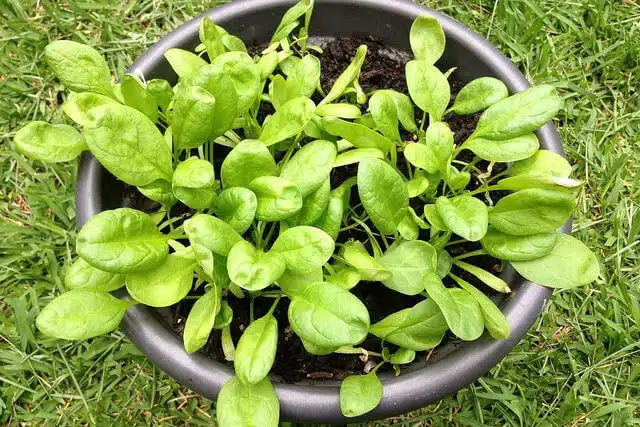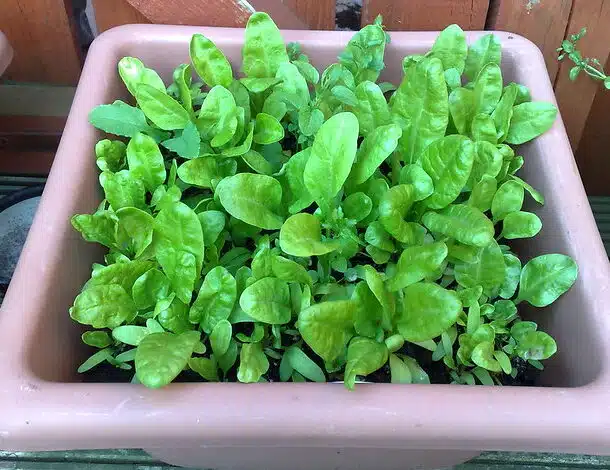Spinach is a fairly easy plant to grow in pots, given its small size. What a lot of people don’t know is that there are two “types” of spinach, winter and summer.
Similarly, whilst it is true that spinach is one of the easier veggies to grow, it does need a few basic requirements met. You’ll also need to do your best to prevent some common problems, in particular downy mildew, blight and bolting.
Because spinach grows more or less year-round it’s good to have available when other greens and veggies have all been harvested at the end of the season. I find that leaves are best used in salads. I’m not averse to steamed spinach (I know some people don’t like the mushy texture), most likely because I ate it a lot when I was a child.
So with that in mind, let’s dive into the specifics of growing spinach in containers.
Factsheet
[ws_table id=”34″]
Sowing and harvesting calendar
[ws_table id=”35″]
Potting soil tips
- Spinach will be grateful for a nutrient-rich mix so add some slow-release fertilizer to your potting soil.
- Drainage is another big consideration, so add some grit, perlite or composted bark to your mix. The addition of fertilizer will make up for any organic matter that you take out.
- If you’re putting together your own potting mix follow a recipe of 1/3 drainage material, 1/3 water-holding (coir, peat, vermiculite etc) and 1/3 rotted down organic matter (manure or compost) with the addition of a balanced slow-release fertilizer.

- If you don’t add any slow-release fertilizer, it will be important to feed regularly. Nutrient-starved spinach can taste bitter.
Sowing and planting
- Summer varieties: sow from early spring (March) through to May for picking up until October.
- Winter varieties: sow around August time. Growth will slow down from the end of November onwards as the cold triggers dormancy in the plants (you can pick leaves until then) but will resume around March time (so you’ll get some greens in April).

- New zealand spinach should be sown in May for picking from June to October.
- Start sowing early in spring. Spinach is very prone to bolting and won’t appreciate the hot summer weather.
- There’s a strong case for successional sowing with spinach. By sowing every couple of weeks from spring through to autumn, you can harvest plants aggressively.
Growing tips
- With spring and summer varieties, dappled shade will guard a little against bolting.So pop the plants in between other pots. For winter varieties, give the plants as much sun as possible.
- Water regularly and don’t let the soil dry out in summer. This can lead to bolting and poor growth.
- You will probably come across “New Zealand Spinach” which is known not to share the same tendency to run to seed (bolt) as other varieties. It’s not actually a true spinach (it’s a member of the Tetragonia genus of the Aizoaceae family while spinach is a member of the Spinacia genus of the Amaranthaceae family) but tastes pretty much the same and can be cooked and eaten in exactly the same way. The same is true of perpetual spinach, which again is not a true spinach but actually a beet leaf/Swiss chard that will grow through winter.
- For winter spinach, a little protection is needed from October onwards in all but the mildest of climates.
Harvesting
- You have two options when it comes to spinach harvesting. You can either take a cut-and-come again approach, snipping off the adolescent outer leaves, leaving the younger leaves to grow, and so on. Alternatively, you can let the plant get bushier and use the mature leaves for cooking. Personally, I much prefer the cut-and-come again approach. I mostly use the leaves in salads.
- If you want to go down the cut-and-come-again route, always pick leaves from the outside. Throughout spring and summer you can take up to half the plant’s leaves. Growth will be vigourous so it can recover. During winter don’t go over 1/3.

- For most varieties, leaves that are around 8cm/3 in. in length are ready for harvesting. For cooking, you can wait until they are double this size.
- Pick off the leaves with your fingernails near the main stem. Avoid aggressively pulling them off.
Pests and problems
Dr. Hessayon points out that there are three (and usually only three) main potential problems with spinach: mildew, bolting and blight. Yellow but otherwise normal leaves are likely caused by a nutrient deficiency and the problem can be solved by feeding.
Here are the main issues to look out for:
- Downy mildew – Two years ago my winter spinach leaves got downy mildew. Parts of the upper side of leaves will turn yellow with a greyish purple mould present too, which is usually more prominent on the underside. Prevent mildew by making sure the plants are well ventilated. Cut off leaves that are affected.
- Yellow leaves – Yellow leaves without any signs of mildew are most likely caused by a nutrient deficiency, manganese in particular. Apply a micronutrient feed, preferably a liquid one. Liquid seaweed is a good option.
- Blight – Rolled leaves and discoloration can be symptomatic of blight. Get rid of the plants and replace the potting mix.
- Bolting – The early flowering of plants is an issue because leaves become bitter and foliage production stops. Prevent bolting by keeping up a strict watering and feeding regimen (or make sure you’ve included slow-release fertilizer in your mix. If you find that your plants are bolting year-after-year, go for New Zealand or Perpetual Spinach.
Good spinach varieties for pots
As I’ve already mentioned you have a choice between summer and winter varieties. Summer varieties tend to have round seeds and are fast-growing. The only problem is that they don’t like heat…and are often quick to run to seed. Placing them in dappled shade (especially when the weather starts to heat up) and watering regularly will go some way in preventing this
You can also grow perpetual spinach and New Zealand spinach, neither of which are really spinaches but which taste more or less the same. Both are less likely to run to seed.
Good varieties for US growers include:
- Bloomsdale – An old variety that produces quite large leaves but with little vertical spread, making it suitable for pots. Resistant to bolting.
- Space (Hybrid) – A compact variety. Its mildew-resistance makes it suitable for planting in autumn/fall.
- New Zealand Spinach – Always a good choice. If you live in a particularly mild climate you can treat it as a perennial.
Good varieties for UK growers include:
- Apollo – A compact variety that also has some resistance to bolting. Plant through spring and pick baby leaves.
- Giant Winter – This might seem an unlikely choice for container growers given its relatively larger size. Winter spinach varieties can be hard to find, however, and Giant Winter is one that’s widely available. The bigger leaves are also good for sparse winter picking.
- Perpetual Spinach – Not a true spinach (as explained above) but a very common choice because of its resistance to bolting and hardiness (suitable for picking through autumn and winter). Plant in from June through to October.
Cooking tips and recipes from around the web
Summer spinaches are wonderful eaten raw in salads. For cooking, the winter varieties are ideal as they tend not to be as tasty raw.
Personally, I’m a big fan of steamed spinach mixed with garlic. I used to love it as a kid! Here are some good recipes from around the web:
- An informative article about the nutritional benefits of spinach, along with lots of cooking tips, from Happy Happy Vegan.
- Creamy Pea and Spinach Pasta (Deliciously Ella)
- Crispy Potato Spinach Balls (Brand New Vegan)
- Vegan Creamed Spinach (The Veg Life)
- Italian Spinach and Kale Salad Recipe (Michele Romano)
More Resources
- The New Vegetable Expert by Dr. D. G. Hessayon – I’ll never tire of recommending this book. It’s my go-to for practically any problem that I have. Unfortunately it’s not widely available in the US.
- Grow Your Own Crops in Pots by Kay Maguire – A simple resource for container growers that’s easy to dip in and out of.
- Salad of the Day: 365 Recipes for Every Day by Georgeanne Brennan – A good salad recipe book.
- RHS guide to spinach.
What are your thoughts? Leave a comment below!
Have you tried growing spinach in containers? Leave a comment below and let me know how it went!
Image credits: Andy2Boyz; Susy Morris; Anna Gregory.
